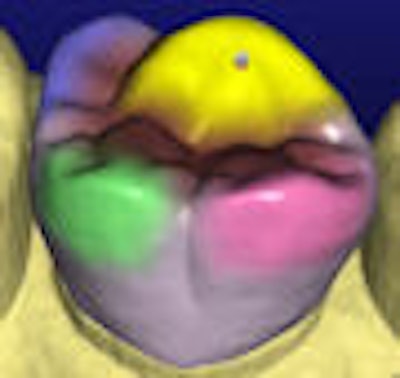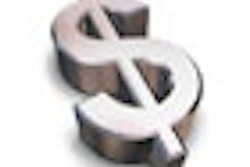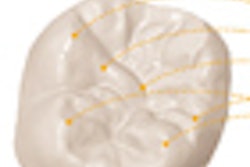
Imagine shopping for a car if the only make was Ford. Or dining out if the only place to eat was Sizzler. For 21 years, that has been the situation dentists faced if they wanted to make crowns and other restorations in their own offices.
This year, the scenario changed.
After years of advance publicity, Dallas company D4D Technologies launched its E4D CAD/CAM system in the first-ever direct challenge to Sirona Dental Systems' Cerec system. The newcomer, while slightly more expensive, offers innovations aimed at tempting dentists away from the more established competitor.
Most notably, dentists using E4D won't need to dust their patients' teeth with titanium powder before making the images needed to design restorations.
But analysts say the newcomer isn't likely to hurt Cerec -- at least in the short term. "Its commercial availability will stimulate adoption of chairside CAD/CAM technology in the U.S.," wrote Jon Wood, a stock analyst from Bank of America.
He and other observers say that the availability of the new system will prod buyers to finally get out their wallets. Many have been waiting to make a purchase until they could compare the two machines. Currently only about 8% of dentists use CAD/CAM in their offices.
And when DrBicuspid.com caught up with Sirona Marketing Coordinator Gabe Foster at the California Dental Association spring meeting, he said his company welcomes the rival. "We think that competition is great for the market," he said. "It pushes us to make sure our product is as good as it can be."
 The E4D CAD/CAM system by D4D Technologies. All images courtesy of D4D.
The E4D CAD/CAM system by D4D Technologies. All images courtesy of D4D.
No studies offering a head-to-head test of which machine is faster or more reliable have so far been published. True comparisons may take years as researchers document how well restorations made on the two machines last.
But D4D is working hard to nudge the older technology aside. "We think we got it much better," said Mark Ebersold, director of dental affairs at D4D, as he showed DrBicuspid.com around the company's headquarters in suburban Dallas. "The Cerec is a great machine. It certainly works. If it was not for their effort, we would not be here. We believe we have taken it to a whole new level."
The machines look similar. For both, you sit at a console mounted on a cart. A computer is attached to a camera wand, monitor, keyboard, and mouse. You position the wand in the patient's mouth and take an image of the tooth to be restored. The image appears on the monitor. You use the mouse and keyboard to manipulate the image in three dimensions, as you design the restoration you want. Both machines do inlays, onlays, crowns, and veneers.
You then load the milling machine with the kind of material you want -- generally one of several types of ceramic. You press a button and the milling machine -- which can be in the same room or at some distance -- uses two opposing diamonds to cut the block into the desired shape.
Key differences
 An operator positions the E4D wand over the tooth to be restored.
An operator positions the E4D wand over the tooth to be restored.
Ebersold stresses the differences in making images. While Cerec bounces infrared light off the tooth, E4D uses a laser. The wands are different shapes, and both companies claim that theirs is easier to get into the patient's mouth.
There is one significant difference, however: the Cerec can't make an image of the tooth surfaces without titanium dioxide being applied to the tooth first. "[You] have to maintain that dry and take a picture, and then clean up afterward," Ebersold said. "If you think about snow drifts, you get an idea of the detail you lose."
When pressed, Ebersold admits that in some cases -- he estimates less than 5% -- the enamel on a patient's tooth is so translucent that the E4D laser won't reflect sufficiently. He argues that this won't happen if dentists prepare the tooth as directed. But when it does, he says, dentists may either apply Accent, a reflective solution, or scan the tooth from other perspectives.
Another difference is that the Cerec scans just once and always from an occlusal perspective -- the equivalent of taking a single exposure. The E4D, on the other hand, takes images from several perspectives, including buccal and lingual.
Ebersold argues that this allows the E4D to obtain more detail. Foster responds that a single scan has more integrity. "When you're stitching images together, you have a high probability of inaccuracy," he said.
 Like the Cerec, the E4D allows operators to design a crown in three dimensions on its screen.
Like the Cerec, the E4D allows operators to design a crown in three dimensions on its screen.
The two systems differ in the milling process as well. The Cerec computer has to keep communicating with the mill until the restoration is ready. The E4D sends instructions to a job server that feeds the information to the mill, freeing the digital cart for another job.
On the other hand, Cerec boasts faster milling speed. Though the time varies depending on the job, the latest Cerec model -- the MCXL -- ranges from four to 10 minutes per restoration, while the E4D "averages" 10 to 15 minutes, according to Ebersold. The E4D mill is also chunkier, weighing in at 250 lb compared to only 70 lb for the Cerec.
Foster is quick to point out another key advantage of Cerec: some 15,000 dentists already own one, so its strengths and weaknesses are pretty well known. If you buy an E4D, you'll be something of a pioneer. Just to look at one, you pretty much have to go to a trade show or fly to Dallas.
"We back up our claims with clinical results," said Foster, who claims a 95% success rate for Cerec restorations. Search Medline under "Cerec" and you'll get 359 hits. Try "E4D" and you'll get none.
There's no real price advantage for the new product either. The E4D runs $116,500. The top-of-the-line Cerec will set you back $109,995, but you can also get the older model with a mill time of eight to 17 minutes for $82,995, or a refurbished unit for $69,995.
Still, some pretty big names are backing D4D in its venture. Partners include Henry Schein (the distributor), 3M, and Ivoclar. Cerec is also associated with heavy hitters; it is distributed by Patterson.
So which machine will triumph? Perhaps neither one. If the market expands as expected, there will be plenty of room for both Ford and Toyota.



















